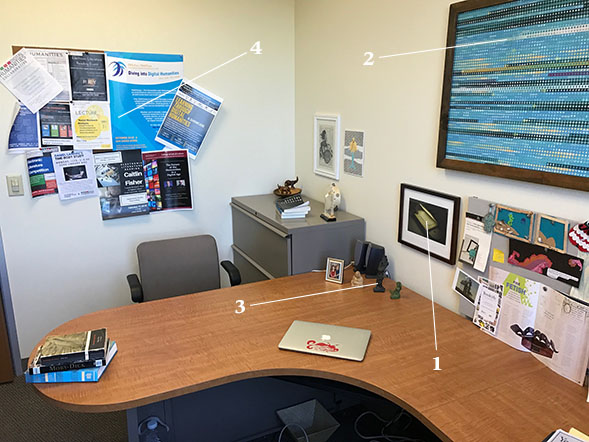Whats On Jessica Pressmans Desk?
The director of SDSUs Digital Humanities Initiative shares the stories behind the items in her workspace.

One of these innovators is Jessica Pressman, an assistant professor of English and comparative literature and director of San Diego State University’s Digital Humanities Initiative.
Recently, SDSU designated “Digital Humanities and Global Diversity” as one of seven interdisciplinary areas of excellence. Through this initiative, SDSU faculty members aim to understand and conduct humanities scholarship in the digital age. The university is hiring faculty, building a lab in the library, and forming a cohort of faculty and students interested in such research.
But what exactly is digital humanities?
"It's an umbrella term used to describe humanities in the digital age," Pressman said. "It can mean studying digital objects, like digital literature which is made and read on the computer. It can also mean using digital tools, such as digital archives or text mining software, to do traditional humanities research.
“Digital humanities means understanding that digital tools and practices affect how we think, read, write and communicate," Pressman said. "The source of humanities research, humanistic records and modes of expression are changing in the digital age, so it is incumbent upon us as humanities researchers and teachers to recognize and engage with these transformations.”
A tour of Pressman’s desk shows a laptop, several books and mermaid figurines—a very clean working area that allows for meetings with colleagues and students. There is a reason for that.
“I use this office for teaching and administrative work," Pressman said. “If you were to go into my office at home, it would be cluttered with papers and books I’m working with in my research. When I come into the office on campus, I really have three jobs: being a teacher, being a colleague and running the Digital Humanities Initiative. Those are very different practices than doing scholarly research, and my workspace reflects that."
Here’s a look at some special items on her desk.
1. “Future of Books” Photograph: "This piece by a British photographer Kyle Bean makes a book look like a laptop computer. To me, this image encapsulates my own research because I look at the media of literature. I'm writing a book called “bookishness,” which is about the fetishization of books in the moment of their supposed disappearance. I buy myself a piece of bookishness to add to my collection."
2. The "Reading Project:" "The work is a nine-minute, Flash animation that flashes words and images onscreen, and contains subliminal messages. I wrote a book about it with two friends, one of whom used data visualiztion software to take a screenshot of every second of the work and arranged it, left to right, top to bottom, laid out spatially like a page. He gave me this beautiful image when we finished the book."
3. Figurines: “I’ve loved mermaids forever and have a collection of them. People buy them for me from all over the world. My grandmother made this. The scultpure is based on "The Winged Victory of Samothrace" in the Louvre. I love the appearance of it. This Buddha is made of sandalwood from China."
4. Digital Humanities Collage: “In a perfect world, I would face the natural view, but I don’t like having my back to people coming into my office. Instead, I face a wall covered with flyers of events that we've organized through the Digital Humanities Initiative. It shows the development of our initiative and spreads across my wall like a network.”



